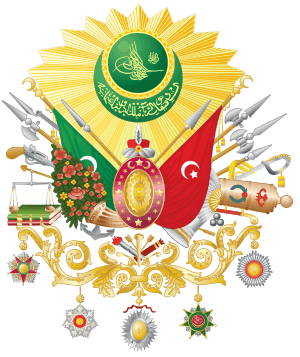Nesrin Kadın
Nesrin Kadın[a] (Ottoman Turkish: نسرین قادین; c. 1848 – 11 June 1876) was the fourth wife of Sultan Abdulaziz of the Ottoman Empire.[1]
| Nesrin Kadın | |||||
|---|---|---|---|---|---|
| Born | c. 1848 Sochi, North Caucasus | ||||
| Died | 11 June 1876 (aged 27–28) Feriye Palace, Istanbul, Ottoman Empire (present day Istanbul, Turkey) | ||||
| Burial | Imperial ladies mausoleum, New Mosque, Istanbul | ||||
| Spouse | |||||
| Issue | Şehzade Mehmed Şevket Emine Sultan | ||||
| |||||
| House | Zevş-Barakay (by birth) Ottoman (by marriage) | ||||
| Father | Ismail Zevş-Barakay | ||||
| Religion | Sunni Islam | ||||
Early life
Nesrin Kadın was born in 1848 in Sochi, North Caucasus. She was a member of Ubykh princely family, Zevş-Barakay.[2] Her father was Prince Ismail Bey Zevş-Barakay (1812 – 1876),[3] son of Prince Vordezokue Bey Zevş-Barakay.[4] Nesrin had two younger brothers, Prince Hasan Bey (1850 – 1876),[5] and Prince Osman Pasha (1851 – 1892), aide-de-camp to Sultan Abdul Hamid II.[6] Her aunt was the wife of Ateş Mehmed Pasha.[2]
In 1859, the Circassian community gathered and a delegation was sent to Istanbul. The aim of the delegation was to present the Russian persecution in the Caucasus to Sultan Abdulmejid I. There were four chiefs who acted as representatives in the delegation including Nesrin's father, Ismail Bey. After they achieved their aim, Abdulmejid requested that the four chiefs stay in the Ottoman Empire, and gifted them with lands. Nesrin's father was given land in Silivri, after which her family settled in Istanbul.[2]
Marriage
Nesrin married Abdulaziz in 1868 at the Dolmabahçe Palace.[7] She was given the title of "Fourth Consort".[8] The marriage was due to her father's efforts to establish political alliance with the Ottoman Empire.[7]
Nesrin gave birth to her first child, a son, Şehzade Mehmed Şevket on 5 June 1872.[9] On 24 August 1874, she gave birth to her second child, a daughter, Emine Sultan.[8] In 1875, she was given the title of "Third Consort".[3]
Abdulaziz was deposed by his ministers on 30 May 1876, his nephew Murad V becoming the Sultan.[10] He was transferred to Feriye Palace the next day.[11] The women of Abdulaziz's entourage didn't want to leave the Dolmabahçe Palace. So they were grabbed by hand and were sent out to the Feriye Palace. In the process, they were searched from head to toe and everything of value was taken from them. Nesrin, who was seriously ill at that time, was carried on a stretcher to the caique, that was to take her to the Feriye Palace. Someone even snatched the shawl that was wrapped around her.[3][12] On 4 June 1876,[13] Abdulaziz died under mysterious circumstances.[14]
Death
Nesrin Kadın died seven days after Abdulaziz's death on 11 June 1876[3] at the Feriye Palace.[15] According to historian Alan Palmer, she apparently died in childbirth.[16] She was buried in the mausoleum of imperial ladies, located at New Mosque, Istanbul.[17]
Four days after her death, on 15 June 1876,[18] her brother, Hasan Bey attempted to assassinate a large number of ministers meeting at the mansion of Midhat Pasha.[19] He was tried, and executed on 18 June 1876.[20]
Issue
Nesrin and Abdulaziz had two children:
- Şehzade Mehmed Şevket (Istanbul, Dolmabahçe Palace, 5 June 1872 – Istanbul, Ortaköy Palace, 22 October 1899), married and had issue;
- Emine Sultan (Istanbul, Dolmabahçe Palace, 24 August 1874 – 29 January 1920, buried in New Mosque, Istanbul), married and had issue;
References
- Gençosman, Kemal Zeki (1976). Yakın tarihimizde rüşvet ve yolsuzluk olayları. ŞDL Yayınları. p. 85.
- Açba 2007, p. 90.
- Uluçay 2011, p. 233.
- Açba 2007, p. 90 n. 51.
- Açba 2007, p. 91 n. 53.
- Açba 2007, p. 93 n. 54.
- Açba 2007, p. 90-1.
- Uluçay 2011, p. 236.
- Bey, Mehmet Sürreya (1969). Osmanlı devletinde kim kimdi, Volume 1. Küğ Yayını. p. 280.
- Zürcher, Erik J. (October 15, 2004). Turkey: A Modern History, Revised Edition. I.B.Tauris. p. 73. ISBN 978-1-850-43399-6.
- Shaw, Stanford J.; Shaw, Ezel Kural (1976). History of the Ottoman Empire and Modern Turkey: Volume 2, Reform, Revolution, and Republic: The Rise of Modern Turkey 1808-1975, Volume 11. Cambridge University Press. pp. 164. ISBN 978-0-521-29166-8.
- Brookes 2010, p. 40.
- Davison, Roderic H. (December 8, 2015). Reform in the Ottoman Empire, 1856-1876. Princeton University Press. p. 341. ISBN 978-1-400-87876-5.
- Brookes 2010, p. 43.
- Açba 2007, p. 91.
- Palmer, Alan (May 19, 2011). The Decline and Fall of the Ottoman Empire. Faber & Faber. ISBN 978-0-571-27908-1.
- Sakaoğlu 2008, p. 642.
- Zücher, Erik J. (September 4, 2004). Turkey: A Modern History, Revised Edition. I.B.Tauris. p. 73. ISBN 978-1-860-64958-5.
- Journal of the Society for Armenian Studies: JSAS. The Society. 1999. p. 116.
- Mattar, Philip (2004). Encyclopedia of the Modern Middle East & North Africa: A-C. Macmillan Reference USA. pp. 575. ISBN 978-0-028-65770-7.
- Öztuna, Yılmaz (March 24, 2014). Bir Darbenin Anatomisi. Ötüken Neşriyat A.Ş. ISBN 978-6-051-55082-4.
Sources
- Uluçay, M. Çağatay (2011). Padişahların kadınları ve kızları. Ötüken. ISBN 978-9-754-37840-5.
- Açba, Harun (2007). Kadın efendiler: 1839-1924. Profil. ISBN 978-9-759-96109-1.
- Sakaoğlu, Necdet (2008). Bu Mülkün Kadın Sultanları: Vâlide Sultanlar, Hâtunlar, Hasekiler, Kandınefendiler, Sultanefendiler. Oğlak Yayıncılık. ISBN 978-6-051-71079-2.
- The Concubine, the Princess, and the Teacher: Voices from the Ottoman Harem. University of Texas Press. 2010. ISBN 978-0-292-78335-5.
